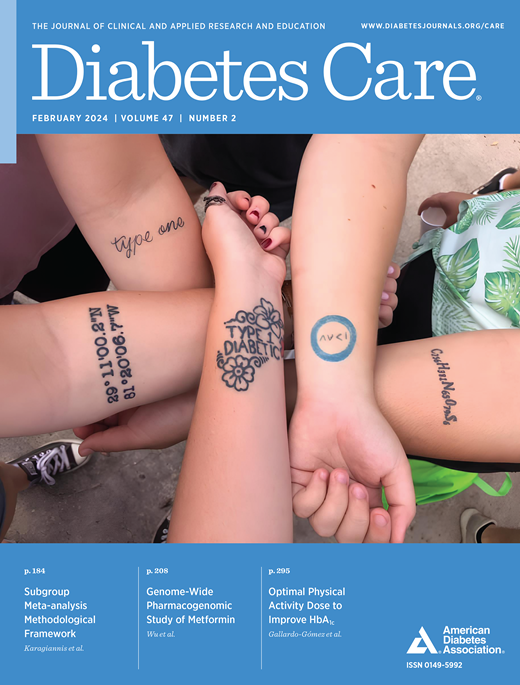Premeal Whey Protein Lowers Postprandial Blood Glucose in Women With Gestational Diabetes Mellitus: A Randomized, Crossover Clinical Trial
IF 16.6
1区 医学
Q1 ENDOCRINOLOGY & METABOLISM
引用次数: 0
Abstract
OBJECTIVE To examine how whey protein served as a premeal affects postprandial glucose excursions in women with gestational diabetes mellitus (GDM). RESEARCH DESIGN AND METHODS A placebo-controlled, single-blinded, crossover, randomized trial including women with and without GDM (20–36 weeks’ gestation) was performed. Participants were studied in the laboratory and at home. In the laboratory, women were randomized to consume 20 g of whey or placebo 30 min before undergoing, 7–14 days later, a 75-g oral glucose tolerance test (OGTT). Blood was sampled consecutively 3 hours following the OGTT. The primary end point was the incremental area under the curve (iAUC) for glucose. At home, participants wore continuous glucose monitors and, on subsequent days, randomly consumed 0, 10, 15, 20, and 30 g of whey 30 min before breakfast. RESULTS Twelve women with GDM and 12 pregnant women with normal glucose tolerance (NGT) to part in the trials. Intake of premeal whey resulted in lowered peak glucose by −1.0 mmol/L (95% CI −1.6 to −0.4) in women with GDM and −0.7 mmol/L (95% CI −1.3 to −0.1) in women without GDM compared with placebo. Insulin, glucose-dependent insulinotropic polypeptide, and glucagon-like peptide-1 levels increased rapidly after whey consumption in both groups. At home, a premeal of 30 g of whey dose-dependently reduced incremental glucose peaks with a maximum of −2.0 mmol/L (95% CI −2.5 to −1.5) in women with GDM compared with placebo. CONCLUSIONS Premeal whey consumption acutely lowers postprandial blood glucose in women with GDM and those with NGT, with 15–30 g lowering the glucose iAUC of women with GDM. These findings emphasize the need for long-term studies to assess the impact of whey premeals in pregnancies affected by GDM.餐前乳清蛋白降低妊娠期糖尿病妇女餐后血糖:一项随机交叉临床试验
目的:探讨乳清蛋白对妊娠期糖尿病(GDM)患者餐前血糖漂移的影响。研究设计和方法采用安慰剂对照、单盲、交叉、随机试验,纳入妊娠20-36周的GDM患者和非GDM患者。参与者分别在实验室和家中接受了研究。在实验室中,女性在接受7-14天后进行75克口服葡萄糖耐量试验(OGTT)前30分钟随机摄入20克乳清或安慰剂。OGTT后3小时连续采血。主要终点是葡萄糖的增量曲线下面积(iAUC)。在家中,参与者连续佩戴血糖监测器,并在随后的几天中,在早餐前30分钟随机摄入0,10,15,20和30克乳清。结果12名GDM患者和12名糖耐量正常的孕妇参加了试验。与安慰剂相比,摄入餐前乳清导致GDM女性血糖峰值降低- 1.0 mmol/L (95% CI为- 1.6至- 0.4),非GDM女性血糖峰值降低- 0.7 mmol/L (95% CI为- 1.3至- 0.1)。两组的胰岛素、葡萄糖依赖性胰岛素性多肽和胰高血糖素样肽-1水平在乳清摄入后迅速升高。在家中,与安慰剂相比,30 g乳清的餐前剂量依赖性降低了GDM女性的葡萄糖增量峰,最大可达- 2.0 mmol/L (95% CI - 2.5至- 1.5)。结论:餐前乳清摄入可显著降低GDM和NGT女性的餐后血糖,其中15-30 g可降低GDM女性的血糖iAUC。这些发现强调需要长期研究来评估乳清预餐对妊娠期糖尿病的影响。
本文章由计算机程序翻译,如有差异,请以英文原文为准。
求助全文
约1分钟内获得全文
求助全文
来源期刊

Diabetes Care
医学-内分泌学与代谢
CiteScore
27.80
自引率
4.90%
发文量
449
审稿时长
1 months
期刊介绍:
The journal's overarching mission can be captured by the simple word "Care," reflecting its commitment to enhancing patient well-being. Diabetes Care aims to support better patient care by addressing the comprehensive needs of healthcare professionals dedicated to managing diabetes.
Diabetes Care serves as a valuable resource for healthcare practitioners, aiming to advance knowledge, foster research, and improve diabetes management. The journal publishes original research across various categories, including Clinical Care, Education, Nutrition, Psychosocial Research, Epidemiology, Health Services Research, Emerging Treatments and Technologies, Pathophysiology, Complications, and Cardiovascular and Metabolic Risk. Additionally, Diabetes Care features ADA statements, consensus reports, review articles, letters to the editor, and health/medical news, appealing to a diverse audience of physicians, researchers, psychologists, educators, and other healthcare professionals.
 求助内容:
求助内容: 应助结果提醒方式:
应助结果提醒方式:


